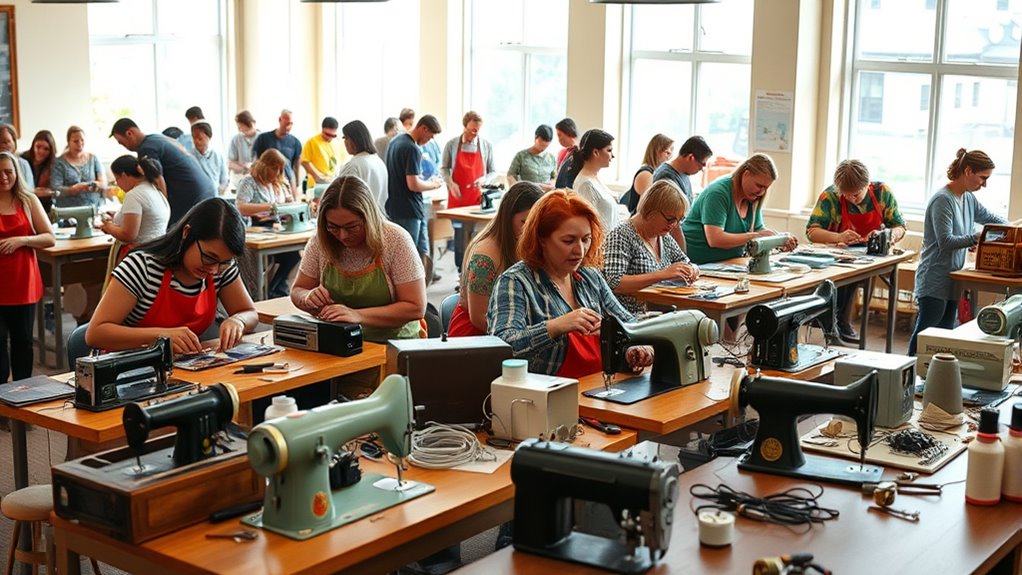Repair cafés are community events where volunteers and residents team up to fix household items like appliances, clothing, or furniture. You can bring your broken items and receive hands-on help, often from skilled repair experts, in a friendly environment. These events encourage sustainable habits by reducing waste and promoting resourcefulness. Organized locally, they also offer workshops and foster connections within neighborhoods. Keep exploring to discover how you can get involved and make a positive impact.
Key Takeaways
- Repair Cafés are community spaces where volunteers assist attendees in fixing household items to extend their lifespan.
- Participants collaboratively work on repairs, guided by skilled repair experts, regardless of their skill level.
- Organized locally by community groups or municipalities, they foster social connections and promote sustainable habits.
- They often include workshops on sewing, electronics, or furniture restoration to build repair skills.
- By repairing items instead of replacing, Repair Cafés reduce waste and support environmentally conscious lifestyles.

Repair Cafés are community-driven spaces where people come together to fix broken household items, from appliances to clothing, instead of discarding them. These gatherings foster a sense of community engagement, encouraging neighbors to connect and share their skills. When you participate in a Repair Café, you’re actively contributing to local sustainability initiatives by extending the lifespan of everyday objects and reducing waste. Instead of tossing out a malfunctioning blender or torn sweater, you learn how to repair them, which helps cut down on landfill contributions and promotes environmentally conscious habits.
At a Repair Café, volunteers and attendees collaborate in a welcoming environment. Skilled repair experts, often volunteers, guide you through fixing your items, offering advice and hands-on assistance. You don’t need to be an expert—most Repair Cafés are open to all skill levels. This setup not only helps you save money but also empowers you to take control of your belongings. You’ll leave with a repaired item and a better understanding of how it works, fostering a DIY mindset that supports sustainable living.
Community engagement is at the heart of Repair Cafés. These events are usually organized locally, often by community groups, environmental organizations, or municipal programs. They serve as a platform where residents can meet, exchange ideas, and develop a collective sense of responsibility for their environment. By participating regularly, you help build stronger local networks and promote a culture that values repairing over replacing. This shared effort amplifies the impact, making sustainability initiatives more effective and visible within your neighborhood.
Furthermore, Repair Cafés often promote educational workshops on topics like sewing, electronics, or furniture restoration, enhancing your skills and awareness. These sessions deepen community ties and foster a culture of reuse and resourcefulness. As more people get involved, the ripple effect encourages others to adopt similar practices, strengthening the community’s commitment to sustainability. The collective action taken at Repair Cafés exemplifies how small, local steps can contribute to larger environmental goals.
In essence, Repair Cafés aren’t just about fixing things—they’re about fostering a sustainable lifestyle rooted in community engagement. Every repaired item is a victory against unnecessary waste, and each participant helps nurture a culture that values durability, resourcefulness, and environmental responsibility. By choosing to repair rather than replace, you become part of a movement that prioritizes the planet’s health while building stronger, more connected communities. Incorporating cost management techniques can further improve the efficiency of such sustainability initiatives and support their long-term success.
Frequently Asked Questions
How Do I Start a Repair Café in My Community?
To start a repair café in your community, you should begin with community outreach to gauge interest and gather support. Recruit volunteers passionate about fixing things and sharing skills, then organize a planning team. Secure a suitable venue, gather necessary tools, and promote your event through social media and local networks. Keep volunteers engaged by offering training and recognizing their efforts. With dedication, you’ll create a thriving space for sustainable repairs and community bonding.
Are There Any Costs Involved to Bring Items for Repair?
Most Repair Cafés don’t charge for bringing items, and around 85% of repairs are free thanks to volunteers. You usually won’t face costs involved to bring items for repair, but donations are appreciated. Volunteer expenses are generally covered by community funding or donations, so you won’t pay extra. Just bring your items, and the friendly volunteers will help you troubleshoot and fix them at no charge.
What Types of Items Can Be Repaired at a Repair Café?
You can bring a variety of items to a Repair Café, including electronic devices and household appliances. The staff and volunteers are ready to help fix things like broken toasters, lamps, smartphones, and small kitchen appliances. While some Repair Cafés might have limited capacity for larger items, they generally welcome many household items and electronics for repair, aiming to reduce waste and help you save money by fixing rather than replacing.
Do I Need to Have Repair Skills to Volunteer?
You don’t need repair skills to volunteer at a Repair Café. In fact, over 80% of volunteers find that training sessions boost their confidence and skills. Skill requirements are minimal; you’re typically guided through volunteer training that covers basic repairs and safety procedures. Your enthusiasm and willingness to learn matter more than expertise, so anyone can contribute and help reduce waste while gaining valuable skills.
How Do Repair Cafés Ensure Sustainability and Eco-Friendliness?
You help guarantee sustainability and eco-friendliness by supporting repair cafés’ recycling initiatives, which reduce waste and extend product lifespans. These cafés promote reusing and repairing items instead of discarding them, lowering environmental impact. By volunteering or participating, you contribute to a circular economy that minimizes landfill contributions. Your involvement encourages mindful consumption, helping protect the environment and foster sustainable habits in your community.
Conclusion
Repair Cafés are like community-powered magic wands, turning waste into worth and bringing neighbors together. By fixing rather than discarding, you help extend the life of items and reduce environmental impact. Your involvement sparks a ripple effect, inspiring others to join the movement. Remember, each repaired item is a small victory for sustainability, proving that together, we can weave a more sustainable future—one fix at a time.








